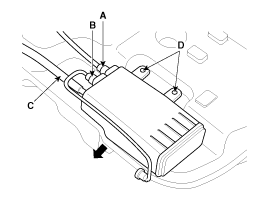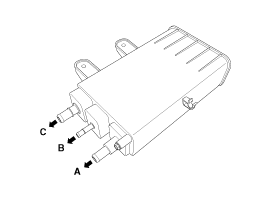Hyundai Tucson: Evaporative Emission Control System / Canister Repair procedures
| Removal |
| 1. |
Remove the fuel tank.
(Refer to "Fuel tank" in FL group.) |
| 2. |
Disconnect the vapor tube quick-connector (A,B) and the ventilation hose (C). |
| 3. |
Remove the canister in the direction of an arrow after removing the installation screws (D).
|
| Inspection |
| 1. |
Check for the following items visually.
- Cracks or leakage of the canister
- Loose connection, distortion, or damage of the vapor hose/tube
A: Canister - Atmosphere
B: Canister - Intake Manifold
C: Canister - Fuel Tank
|
| Installation |
Canister installation bolt/nut:
3.9 ~ 5.9 N.m (0.4 ~ 0.6 kgf.m, 2.9 ~ 4.3 lb-ft) |
 Repair procedures
Repair procedures
Inspection
[EVAP. Leakage Test]
1.
Select "Evap. Leakage Test".
2.
Proceed with the test according to the screen introductions. ...
 Fuel Filler Cap Description and Operation
Fuel Filler Cap Description and Operation
Description
A ratchet tightening device on the threaded fuel filler cap
reduces the chances of incorrect installation, which seals the fuel
filler. After the gasket on the fuel filler cap and t ...
Other information:
Hyundai Tucson (LM) 2010-2015 Owners Manual: Voice Command List
Common Commands:
These commands can be used in most operations. (However a few commands may not
be available during certain operations)
FM/AM radio commands:
Commands available during FM, AM radio operation
Satellite radio commands:
Commands that can be used while listening ...
Hyundai Tucson (LM) 2010-2015 Service Manual: Positive Crankcase Ventilation (PCV) Valve Repair procedures
Removal
1.
Disconnect the vapor hose (A).
2.
Remove the PCV valve (B).
Inspection
1.
Insert a thin stick (A) into the PCV valve (B) from the threaded side to check that the plunger movement.
•
If the plunger does not move (PCV valve is clogged), clean or re ...


